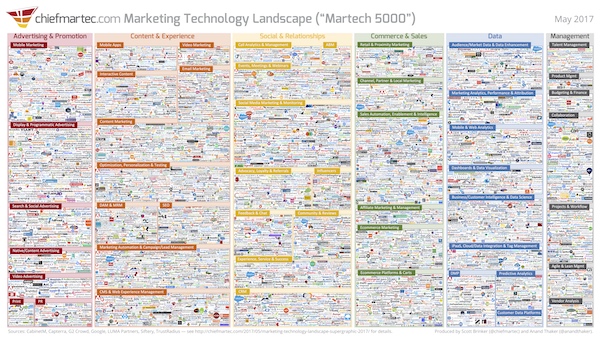
Survival in the wild means blending in and camouflaging one’s appearance to avoid being seen by prey. It’s just the opposite in marketing. Prioritize market differentiation. Be noticed or die. And with all the flashy ways to get noticed evolving daily, it’s a tough world to compete in.
If you’re going to buy a predictive analytics software right now, you’ll probably start asking among friends, before heading out to research on Google. Then you’ll find there are a bazillion options to go for.
Truth is, the best marketer — who knows how to differentiate their product and frame why they’re better for you than the other brand — will be noticed. This happens in every industry, whether marketing for financial services or a donut-selling brand.
Behind every innocent-looking free tool, content, or platform is an ad, a pitch targeted at converting readers and users into buyers. And that’s part of why a typical human sees about 5000 ads a day. Survival is indeed the word that describes what marketers are up against in 2018.
Imagine the amount of competition in the marketing technology (martech) space alone:
While this represents the competition among companies selling or marketing to marketers, it’s the same in most other industries. And this level of competition across all industries has forced buyers to change what influences their decisions in these past few years. And of course, marketers need to adapt to that change accordingly.
A buyer who used to have only a handful of options to pick from now has perhaps hundreds. If you happen to be selling a CRM software, for instance, you have you over 400 rivals to deal with every day.
It’s a good thing for buyers. But for marketers, it means more work. Marketers now need to be smarter, faster, and more clever than ever. The name of the game is keep up or lose out big to better marketers in the industry.
Enter market differentiation
If marketing any product is as crowded as it looks right now, marketers need differentiation to survive. Differentiation makes customers have a justifiable reason to patronize both you and your competitors — even if you both sell similar products.
Truth is, every marketer knows what differentiation is and how it helps them. What’s not really clear is how to differentiate. Here are three great options:
Make your product’s uniqueness your poster guy
Virtually every product these days has unique capabilities. But not every business spells their rare capabilities out clearly.
Make your product’s uniqueness your main attraction. Q&A site FixYa, for instance, is competing with two of the businesses in the world many marketers would dread competing with — Quora and Yahoo.
When the company launched in 2005, there was almost no noticeable or huge rival for them — until Yahoo Answers showed up in 2006 and Quora in 2009. Even though FixYa was uniquely different, users became distracted by these two new industry entrants.
To remedy the situation, FixYa put in more effort to personalize what they offered, and made their uniqueness their poster guy. Every new feature, campaign, and copy speaks directly to people looking for help with their broken gadgets. FixYa founder Yaniv Bensadon says “There are 30 million users who land on the FixYa site and we know exactly what’s not working for them.”
To further demonstrate they cater to users looking for product-fixing answers, FixYa launched an “experts on demand” feature that allows people to sell technical-support services by creating their own expert profiles on the site, and users can rate them.
Long story short, they’ve made it clear what they want to be known for that’s different from Quora and Yahoo Answers — A Q&A resource for fixing broken consumer products.
And they have this unique difference infused in their materials everywhere — it’s even first thing you see on their homepage.

They’re clearly different from Quora’s “What’s Your Question” or Yahoo Answers’ “Search Answers.”
This way, while FixYa is in the Q&A space, users know exactly what to use them for that’s different from other Q&A sites. When you make your USP or product uniqueness your poster guy, it becomes easier to beat the competition.
Next, urgency and exclusivity.
Urgency and exclusivity
They’re both old strategies, but still effective today. Urgency makes users feel they need to act now. Exclusivity generates leads (and paying customers) by making those folks feel as if they’ve joined a club only they and a few others can get into.
It doesn’t matter how much competition there is in the market, infusing urgency and exclusivity into your value (tool, content, etc.) compels prospects to want to convert before your offer goes away.
This form below (with the urgency and exclusivity concept) helped smoking accessories provider HEMPER get 40,000 leads in 10 months — 4,000 leads per month on the average.

There’s a timer on the form, telling visitors as they’re about to leave (Hemper uses the exit intent technology) to grab a giveaway before they won’t get the opportunity anymore. End result? 40k leads in just 10 months (about 4k every month), converting at the rate of 22 percent.

Source: A sumo.com newsletter
And if you’ve been marketing anything at anytime, you know how generating 40,000 leads in 10 months can be a big deal. The principle of exclusivity and urgency can make prospects ignore your competitors and sign up for your offer before it disappears.
Next, stand out with content.
Stand out with content
Content is another way marketers can differentiate. Every brand does content marketing in one way or another, but look at what your competitors are doing and start creating content that’s different from theirs.
Customer support software Groove launched in 2013 — a time when there were several incumbents. What Groove used to differentiate itself from other customer service tools was content — in the form of stories. There were other customer support software creating content at the time, but most of them weren’t putting out stories of actual experiences readers were facing.
Groove saw this gap and decided to fill it.
Groove Founder Alex Turnbull says, “And as far as we searched, we couldn’t find any other content publishers telling that story: the real story of a small business, struggling with the same challenges as everyone else, and sharing everything that they learned along the way. It wouldn’t be enough to just share ‘lessons learned,’ of course. There was plenty of content out there for that. But nothing told the story in a way that mirrored the real experience of most small businesses; a narrative that started with the creation of the company and followed it, step by step, win by win, fail by fail, lesson by lesson, through its journey.”
Today the company makes over $5 million in annual recurring revenue (ARR), and they say it’s thanks to their content being different to what was already in the market.
“Today, more than 250,000 people read our content each month, more than 5,000 customers trust us with their business, and we’re generating nearly $5 million in annual recurring revenue,” said Alex.
All because their content was different from what competitors were posting (and of course they had good content promotion tactics and great stories to tell). Their target audience resonates with the stories because they go through it themselves, and nothing beats that.
Brian Clark of Copyblogger put it this way: “…when you understand the worldview your prospects share — the things they believe — you can frame your story in a way that resonates so strongly with them that you enjoy an ‘unfair’ advantage over your competition.”
In other words, there’s no better way to engage your target customers with content than knowing your audience really well. As someone who does content marketing specifically for marketing companies, I can relate well to what Groove said about creating content for a particular audience that they know so well. There’s really no way to engage and convert people with content without knowing who they are, and what they really want.
Understand what your target customers go through, what they want to achieve, and how they can do that. By knowing your customers, you will always have a new yarn to spin.
However make it different from what the competition is publishing. For Groove it was stories that made the difference, for your brand it could be something else — more in-depth or longer posts, videos, infographics, whitepapers, or any other form of content your rivals are overlooking.
In conclusion, you just need to put a great deal of effort into market differentiation; things different rarely go unnoticed. And that’s the way to survive in marketing today.
Get the TNW newsletter
Get the most important tech news in your inbox each week.





